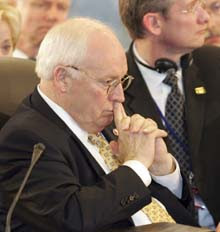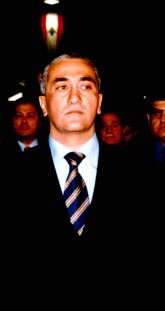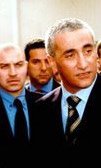
CIA and Other Intelligence Agency Links to Global Drug Trade (Video)
VIDEO: "An Unholy Alliance" - Documentary examines CIA and other
intelligence agency links to the global drug trade.
Video google (entire film - better frame rate than YouTube version);
http://video.google.com/videoplay?docid=5302066364516949312&hl=enIn 1996, directors Chris Hilton and David Roberts released "An Unholy
Alliance" as the second part of a trilogy of documentaries dealing with
the global drug trade; with a focus on heroin and opium. The documentary
offers a valuable history of the drug trade, with much rare footage,
including footage of CIA favorite, Gulbuddin Hekmatyar. Since Hekmatyar
is back in the news, now is an important time to remind people of
Hekmatyar's dubious past, and his links to the heroin industry in
Afghanistan and Pakistan.
The CIA and the Afghan Arabs
An Unholy Alliance starts off in Peshawar, which was a major hub of
activity for the CIA and the ISI, as they deployed the Afghan Mujahadin
in a proxy war against the Soviet Union, beginning in 1979. Since the
1980s, CIA apologists like Peter Bergen, and former CIA station chief
Milton Bearden have claimed that the CIA never directly trained the
Mujahidin and the associated Arabic recruits;
Peter Bergen: "While the charges that the CIA was responsible for
the rise of the Afghan Arabs might make good copy, they don't make good
history. The truth is more complicated, tinged with varying shades of
gray. The United States wanted to be able to deny that the CIA was
funding the Afghan war, so its support was funneled through Pakistan's
Inter Services Intelligence agency (ISI). ISI in turn made the decisions
about which Afghan factions to arm and train, tending to favor the most
Islamist and pro-Pakistan. The Afghan Arabs generally fought alongside
those factions, which is how the charge arose that they were creatures
of the CIA."
Milton Bearden: "Contrary to what people have come to imagine, the
CIA never recruited, trained, or otherwise used Arab volunteers. The
Afghans were more than happy to do their own fighting -- we saw no
reason not to satisfy them on this point."
The above quotes are taken from the U.S. State Dept's "Identifying
Misinformation" website, which is currently unavailable. Here is the
cached version at the Internet Archive;
http://web.archive.org/web/20070216114721/usinfo.state.gov/media/Archive...
However, during the 1980s, the Reagan administration was using the US
corporate media to openly brag about training the Mujahidin, via the
CIA, which certainly by 1986 had Arab volunteers fully woven into the
Mujahidin forces. In An Unholy Alliance, the directors include a
valuable segment from NBC News, March, 1986;
"Anti-communist guerillas in Afghanistan have been at the front
line against the spread of communism in the Third World. And now they'll
be better armed. The Reagan administration has decided to give the
rebels Stinger missiles. The Stinger is a US-made anti-aircraft missile.
It's portable, shoulder-fired, and capable of hitting a helicopter or
jet from a distance of 5 miles. It would provide the rebels with a
viable defense against Soviet helicopter gunships, and MIG fighter jets.
One administration source indicated the CIA would be responsible for
training the guerillas in their use."
This occurs at the 4:18 mark, Part 1, of the YouTube version.
Despite proclamations from Bearden, et al, prior to 9/11, the
relationship between the CIA, the 'Arab Afghans' and Osama Bin Laden was
perfectly clear, as evidenced in Ahmed Rashid's "Taliban";
"...in 1986, CIA chief William Casey had stepped up the war against
the Soviet Union by taking three significant, but at that time highly
secret, measures. He had persuaded the U.S. Congress to provide the
Mujaheddin with American-made Stinger anti-aircraft missiles to shoot
down Soviet planes and provide U.S. advisers to train the guerrillas.
Until then no US-made weapons or personnel had been used directly in the
war effort. The CIA, Britain's MI6 and the ISI also agreed on a
provocative plan to launch guerrilla attacks into the Soviet Socialist
Republics of Tajikistan and Uzbekistan, the soft Muslim underbelly of
the Soviet state from where Soviet troops in Afghanistan received their
supplies. The task was given to the ISI's favourite Mujaheddin leader
Gulbuddin Hikmetyar. In March 1987, small units crossed the Amu Darya
river from bases in northern Afghanistan and launched their first rocket
attacks against villages in Tajikistan. Casey was delighted with the
news, and on his next secret trip to Pakistan he crossed the border into
Afghanistan with President Zia to review the Mujaheddin groups.
Thirdly, Casey committed CIA support to a long-standing ISI
initiative to recruit Muslims from around the world to come to Pakistan
and fight with the Afghan Mujaheddin. The ISI had encouraged this since
1982 and by now all the other players had their reasons for supporting
the idea." p.129
--------------------------
"His father backed the Afghan struggle and helped fund it, so when
Bin Laden decided to join up, his family responded enthusiastically. He
first traveled to Peshawar in 1980 and met the Mujaheddin leaders,
returning frequently with Saudi donations for the cause until 1982, when
he decided to settle in Peshawar. He brought in his company engineers
and heavy construction equipment to help build roads and depots for the
Mujaheddin. In 1986, he helped build the Khost tunnel complex, which the
CIA was funding as a major arms storage depot, training facility and
medical center for the Mujaheddin, deep under the mountains close to the
Pakistan border. For the first time in Khost he set up his own training
camp for Arab Afghans, who now increasingly saw this lanky, wealthy and
charismatic Saudi as their leader.
'To counter these atheist Russians, the Saudis chose me as their
representative in Afghanistan,' Bin Laden said later. 'I settled in
Pakistan in the Afghan border region. There I received volunteers who
came from the Saudi Kingdom and from all over the Arab and Muslim
countries. I set up my fist camp where these volunteers were trained by
Pakistani and American officers. The weapons were supplied by the
Americans, the money by the Saudis." p.132
An Unholy Alliance the filmmakers interview the late Muslim
intellectual, Dr. Eqbal Ahmad. Ahmad was in Pakistan when these
historical events were unfolding. He witnessed the smuggling of arms
into Afghanistan, via camels, and the same smugglers would return with a
supply of drugs. He also personally witnessed the importation of the
Arab volunteers into Afghanistan;
"...an Islamic fundamentalist dictator in Pakistan, Zia ul-Haq,
promoted, with the help of the CIA, the mujahideen resistance. Now what
you had was Islamic fundamentalists of a really hardcore variety taking
on the Evil Empire. They received $8 billion in arms from the U.S.
alone. Add another $2 billion from Saudi Arabia under American
encouragement. And, more than that, American operatives went about the
Muslim world recruiting for the jihad in Afghanistan. This whole
phenomenon of jihad as an international armed struggle did not exist in
the Muslim world since the tenth century. It was brought back into
being, enlivened, and pan-Islamized by the American effort. The United
States saw in the war in Afghanistan an opportunity to mobilize the
Muslim world against communism. So the United States recruited
mujahideen from all over the Muslim world. I saw planeloads of them
arriving-from Algeria, the Sudan, Saudi Arabia, Egypt, Jordan, and
Palestine. These people were brought in, given an ideology, told that
the armed struggle is a virtuous thing to do, and the whole notion of
jihad as an international, pan-Islamic terrorist movement was born.
They were trained and armed by the CIA. The militants of the
Islamic movement almost everywhere have all been trained in Afghanistan.
The CIA people now call it "Islamic blowback."
Like Milton Bearden, Dr. Ahmad was there, he saw and felt the effects of
the CIA's involvement on a first-hand basis, in real-time. How strange
that his experience proceeds 180 degrees away from the Bergen/Bearden
line. (Among the CIA's tea-leaf readers, Steve Coll has really been the
only one to offer insight and new information on the cooperation between
CIA, the ISI and Saudi Arabia's GID in the accumulation of Arab
volunteers for the Afghan resistance in his book "Ghost Wars", but there
are places that Coll will not tread, such as the drug trade.)
Michael Levine is also interviewed in An Unholy Alliance, and reveals in
condensed form his experiences with the DEA. When Levine was at the cusp
of breaking apart major drug syndicates, there would suddenly be
interference, scuttling the operation, form agencies like the CIA as
well as political interefence from Washington. In his 1993 book, "The
Big White Lie", Levine writes;
"For decades, the CIA, the Pentagon, and secret organizations like
Oliver North's Enterprise have been supporting and protecting the
world's biggest drug dealers. Those brave freedom fighters in
Afghanistan, the Mujahedin, supply a major portion of the heroin used in
the United States. The Contras and some of their Central American allies
like Honduras have been documented by DEA as supplying us with at least
50 percent of our national cocaine consumption. They were the main
conduit to the United States for Columbian cocaine during the 1980s. The
rest of the drug supply for the American habit came from other
CIA-supported groups, such as DFS (the Mexican equivalent of the CIA),
the Shan United Army in the Golden Triangle of Southeast Asia, or any of
a score of other groups and/or individuals like Manuel Noriega. Support
of these people has been deemed more important than gettng drugs off our
streets." (p.463, Thunder's Mouth hardcover edition.)
Peter Dale Scott's Observations on the Drug Relationship
In 2003's "Drugs, Oil and War" Scott writes;
"In the half century since the Korean War the United States has
been involved in four major wars in the Third World: in Vietnam
(1961-1975), in the Persian Gulf (1990-1991), in Colombia
(1991-present), and in Afghanistan (2001-2002). All four wars were
fought in or near significant oil-producing areas. All four involved
reliance on proxies who were also major international drug traffickers.
The American habit of training, arming, and financing its
drug-trafficking allies in order to help secure oil resources abroad has
been a major factor in the huge increase in global illicit drug
trafficking since World War II.
This pattern is further reinforced when we consider two of
America's major indirect interventions of the same period: support for
the Nicaraguan Contras (1981-1988) and the Afghan mujahedin (1979-1991).
The CIA contracted for Contra support in Central America with an airline
owned by a ringleader of the largest cocaine network in the region. By
providing funds for Gulbuddin Hekmatyar, a drug trafficker selected for
support by Pakistani intelligence (the Inter-Services Intelligence
Directorate, or ISI), the CIA helped propel Hekmatyar into becoming, for
a while, the lagest heroin trafficker in Afghanistan and perhaps the world.
All empires since the Renaissance have been driven by the search
for foreign resources, and nearly all - including the British, the
French, and the Dutch - used drugs as a cheap way to pay for overseas
expansion. When the United States decided to preserve Western influence
in Southeast Asia, it inherited a social structure of former colonial
regimes that had coexisted in one way or another with powerful Chinese
Triads engaged in the drug traffic...
...American dependence on drug proxies can be traced to the CIA
decision, in 1949-1950, to provide arms and logistic support to the
residual forces of the Chinese Kuomintang in Burma. This evolved into
the much larger program of support for the opium-growing Hmong tribesmen
in northeastern Laos. In the wake of the domestically unpopular Vietnam
War, the United States, in asserting an increasingly explicit
geostrategic interest in oil reserves throughout the world, has
continued to seek out local drug proxies as a supplement or an
alternative to the use of U.S. armed forces." (p.27-28, Rowman &
Littlefield softcover)
In 2007's "Road to 9/11";
"In May 1979 the ISI put CIA in touch with Gulbuddin Hekmatyar, the
mujahideen warlord with perhaps the smallest following inside
Afghanistan. Hekmatyar was also the leading mujahideen drug trafficker,
and the only one to develop his own complex of six heroin labs in an
ISI-controlled area of Baluchistan (Pakistan). ... As an Afghan leader
in 1994 told Tim Weiner of the New York Times: "We didn't choose these
leaders. The United States made Hekmatyar by giving him his weapons. Now
we want the United States to shake these leaders and make them stop the
killing, to save us from them." Foreign correspondent Robert D. Kaplan
reported his personal experience that Hekmatyar was "loathed by all the
other party leaders, fundamentalist and moderate alike."
It is easy to understand why Pakistan insisted that Hekmatyar
receive the bulk of U.S. (and Saudi) aid. He was the mujahideen leader
most dependent on the ISI for survival, and allegedly the only one
willing to accept the British-drawn Durand Line as the Afghan-Pakistan
boundary. The question is rather why Brzezinski agreed to an alliance
with this drug connection, and proceeded almost immediately to protect
it from critical snoops like David Musto.
...
The consequences of Brzezinski's decision were felt immediately, in
the form of a sudden flood of heroin from the Afghan border into the
United States. In May 1980, only five months after arms began to flow to
the Afghan guerrillas, Carter's White House adviser on drugs, Musto,
complained publicly of the risks "in befriending these tribes as we did
in Laos." Musto noted that the number of drug-related deaths in New York
had risen by 77 percent. The key to this relationship may have been
BCCI. Well into the 1980s the bank continued the cut-out activities for
CIA that had been performed earlier by billionaire Saudi arms dealer
Adnan Khashoggi and Kamal Adham, who became one of BCCI's principal
shareholders.
...
On the Pakistan side this criminal relationship may even have been
institutionalized. According to B. Raman, a well-informed Indian analyst
writing in the Financial Times: "In the 1980s, at the instance of the
Central Intelligence Agency (CIA) of the US, the Internal Political
Division of the Inter-Services Intelligence (ISI), headed by Brig
(retd). Imtiaz, ... started a special cell for the use of heroin for
covert actions. This cell promoted the cultivation of opium and the
extraction of heroin in Pakistani territory as well as in the Afghan
territory under Mujahideen control for being smuggled into the Soviet
controlled areas in order to make the Soviet troops heroin addicts.
After the withdrawal of the Soviet troops, the ISI's heroin cell started
using its network of refineries and smugglers for smuggling heroin to
the Western countries and using the money as a supplement to its
legitimate economy. But for these heroin dollars, Pakistan's legitimate
economy must have collapsed many years ago." (pp.74-76, University of
California Press hardback)
Who is trying to maneuver Hekmatyar back into Afghanistan? That is the
question....



















